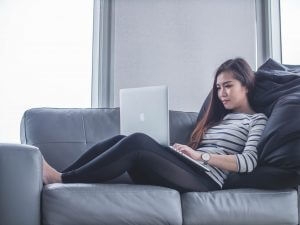Working from Home Transition
Out of all the changes that have taken place over the last few weeks following the COVID-19 pandemic, none has been more widespread and drastic than the “working-from-home” transition most employees had to face.
In a matter of days employees went from socially vibrant and ergonomically sound offices to sharing workspaces with the rest of the family and interacting with their colleagues and managers virtually.
Poor workspace setups
With a few weeks gone by since this transition, many employers have started to see an increase in employee reports of pain and strains linked to a poor workspace setup at home. Sore wrists, stiff necks, painful backs, and headaches and becoming more regular complaints. To help prevent some of these discomforts or worse, injuries, you can read one of our previous blog with top tips to setup your work from home workspace.
Many employees unfortunately didn’t have the luxury (or necessity) to have the same quality setup at home as they had in the office – stand up desks, ergonomic chairs, one or multiple monitors. For the majority of workers, they are currently working from home by simply using a laptop computer.
Working from a Laptop
Laptops are great tools as they make it possible for your employees to work from anywhere in the world. They are light, compact and include everything you need to do work – a screen, a keyboard and a trackpad as a mouse.
But let’s face it, if you have ever attempted to work from a laptop on an airplane for a couple of hours you would know that working from a laptop for an extended period of time can be an ergonomic disaster and can also lead to a loss of productivity.

So here are a few additional tips specifically for your working from home laptop users:
Keyboard, Mouse and Screen
If you can, always use your laptop with a separate keyboard, mouse and monitor. For a start, having a keyboard and a screen as part of a same unit is a big issue. On a laptop keyboards and screens are much smaller and compact than on a desktop computer and will force you into a bad posture (hunching over) and put additional strain on your neck and on your eyes. A laptop raiser is ideal to allow the top of your screen to be raised to eye level for you. But if you don’t have a raiser, you can also use books or boxes to recreate the same effect.
If this is still not possible and you only have a laptop to work from, try to incorporate these top tips:
- Avoid the ‘C’ curve shape in your back when sitting, try to keep the natural ‘S’ curve shape.
- Avoid using your laptop while lying on your couch or bed.

- Sit in a supportive chair at a desk or level surface that allows you to achieve your elbows above the desk at 90 angles with your shoulders relaxed.
- Ensure your feet are in contact with a firm surface.
- Keep your hips and knees at neutral 90 angles.
- Do not use your laptop for more than 1 hour without taking a break.
- Stretch and take micropauses. Take walking phone calls around your house or even outside.
- Take video calls standing up, placing your laptop on a higher surface.
- Vary your tasks: Repetitive tasks can lead to physical and mental fatigue too.
- Work your regular hours and when you close your laptop, switch off work mode and relax. It has been proven that leaving your computer on makes it harder for you to also switch off, especially if it is visible and setup in a “common” room and not a separate office.
- Get your WFH employees a professional and virtual Workspace Assessment.
So, while using a laptop for 8 hours a day weeks on end is certainly not the best practice, implementing a few tips and professional “hacks” can go a long way to make it a lot safer and more comfortable for your employees working from home.
Get in contact if you would like more details or to organise some Virtual Ergonomic Assessments. It is the best way to ensure your people are adequately and ergonomically setup at home. These interactive sessions can now be done virtually with your employees. They are conducted by a qualified health specialists, quick, easy to organise and can save you a lot of time and headaches having to deal with employees’ complaints, time off work or even claims due to injuries.
For more information about our leading behaviour change programs call us on
Australia : info@vitalityworks.com.au
New Zealand : info@vitalityworks.co.nz
Or click below to send us an enquiry
Contact Us

